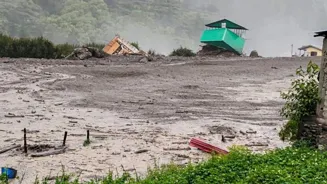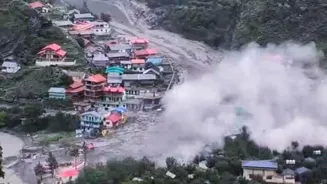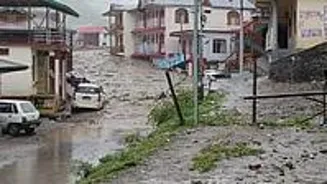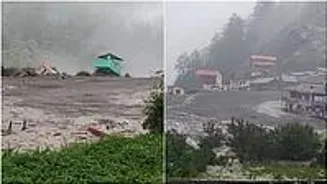Uttarkashi Cloudburst: A cloudburst led to flash floods in the high altitude villages of Dharali on the way to Gangotri on Tuesday with several houses damaged or swept away in the raging waters and at least
four people killed, officials said. Dharali is the main stopover on way to Gangotri and home to many hotels, restaurants and home stays. The devastating flashflood came in the wake of a cloudburst somewhere in the catchment area of the Kheer Ganga river, locals said.
Uttarakhand Cloudburst LIVE Updates Here
According to initial reports, at least four people have died, Uttarkashi District Magistrate Prashant Arya told reporters. An Army team from Harsil has been rushed to the spot. About 10-12 people could be buried under the debris, Rajesh Panwar, a villager, told PTI. He said 20-25 hotels and homestays may have been washed away.
#WATCH | Uttarakhand Cloudburst: Devastation and Debris All Around. Badrinath NH-58 Blocked Due To Debris From Landslide, Work Of Removing The Debris Is In Process#Badrinath #Landslide #Cloudburst #Uttarakhand pic.twitter.com/NHEFo1vbEb
— News18 (@CNNnews18) August 5, 2025
“The news of heavy losses due to cloudburst in Dharali (Uttarkashi) area is extremely sad and painful. SDRF, NDRF, district administration and other related teams are engaged on war footing in relief and rescue operations,” Chief Minister Pushkar Singh Dhami said in a post on X. “I am constantly in touch with senior officials in this regard and the situation is being closely monitored. I pray to God for everyone’s safety,” he said.
There was widespread panicin the neighbouring villages following the flashflood. Videos from the area showed a torrent of muddy water and silt rushing down the slopes towards settlements along the banks of the river. People could be heard screaming in fear. In one video, people can be heard in the video gasping for breath and trying to call their relatives in affected areas to find out if they were alright. A voice is heard in the video saying, “Everything is finished.”
धराली (उत्तरकाशी) के प्रभावित क्षेत्रों में जिला प्रशासन, भारतीय सेना, NDRF एवं SDRF की टीमें राहत और बचाव कार्यों में जुटी हुई हैं। प्राथमिकता के आधार पर लोगों को सुरक्षित स्थानों पर पहुंचाया जा रहा है और स्थिति पर लगातार निगरानी रखी जा रही है। प्रशासन पूरी तरह सतर्क है और… pic.twitter.com/EV2ykxQ0bA
— Pushkar Singh Dhami (@pushkardhami) August 5, 2025
What is a cloudburst?
A cloudburst is a sudden, very intense rainfall event that usually lasts for a short period (typically a few minutes to a few hours) but releases a massive amount of water in a small area. It’s often associated with thunderstorms and can lead to flash floods, landslides, and severe damage, especially in hilly or mountainous regions.
What exactly happens in a cloudburst?
It occurs when moisture-laden clouds are unable to release rain gradually. Instead, the moisture accumulates rapidly and is released all at once due to strong convection currents or unstable atmospheric conditions. The result: 100 mm or more of rain may fall within an hour over a very localized area (e.g., 10 km² or less).
Where do cloudbursts usually occur?
Common in mountainous regions like the Himalayas (India, Nepal, Pakistan), where orographic lifting (air rising over mountains) enhances rainfall.
Also seen in desert regions or during monsoons, where intense heating leads to strong convection.
Houses wiped out, chaos, debris and destruction everywhere.
As Uttarakhand battles with a massive disaster, rescue operations are underway after the havoc wreaking cloudburst. A few glimpses of the action underway at ground zero #Uttarakhand #Cloudburst #Rainfall #Monsoon… pic.twitter.com/ZFLosPyogV
— News18 (@CNNnews18) August 5, 2025
How much water do clouds hold?
A typical rain cloud — especially cumulonimbus clouds (thunderstorm clouds) — can weigh hundreds of thousands to millions of tons, made up of tiny water droplets and ice particles suspended by rising air.
These clouds can span many kilometres in height and width. For example, a cloud just 1 km³ in volume can hold up to 500 million litres of water vapour.
What triggers a sudden downpour?
In events like cloudbursts, a perfect storm of conditions occurs:
Strong updrafts (rising warm air) keep large amounts of water suspended.
Once the air can’t hold it anymore, due to cooling or a sudden disruption (like wind shear or collision with mountains), the entire load of water falls rapidly as rain.
This process is highly localized, often hitting a small area intensely — like pouring an entire swimming pool on a small neighborhood.
Billion litres possible in a minute?
1 km² area receiving 100 mm of rain (which is 0.1 m) =
1,000 m × 1,000 m × 0.1 m = 100,000 m³
= 100 million litres in a single downpour.
If 10 km² is affected at once:
100 million litres × 10 = 1 billion litres.
This much water can fall in a minute or less during a cloudburst — especially when rainfall exceeds 100 mm/hour or even reaches 200-300 mm/hour, which has been recorded in events in the Himalayas and Western Ghats.
Which were some of the worst cloudbursts?
Leh, India (2010): A cloudburst dropped ~75 mm of rain in just 30 minutes over a tiny area, causing devastating flash floods.
Kedarnath, India (2013): Cloudbursts triggered massive floods and landslides, killing thousands.
Uttarakhand (2023–24): Several instances of 100–150 mm of rain in under an hour were recorded, dumping hundreds of millions of litres.














